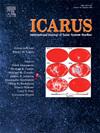Lunar impact ejecta flux on the Earth
IF 3
2区 物理与天体物理
Q2 ASTRONOMY & ASTROPHYSICS
引用次数: 0
Abstract
The transfer of material between planetary bodies due to impact events is important for understanding planetary evolution, meteoroid impact fluxes, the formation of near-Earth objects (NEOs), and even the provenance of volatile and organic materials at Earth. This study investigates the dynamics and fate of lunar ejecta reaching Earth. We employ the high-accuracy IAS15 integrator within the REBOUND package to track for 100,000 years the trajectories of 6,000 test particles launched from various lunar latitudes and longitudes. Our model incorporates a realistic velocity distribution for ejecta fragments (tens of meters in size), derived from large lunar cratering events. Our results show that 22.6% of lunar ejecta collide with Earth, following a power-law , with half of the impacts occurring within 10,000 years. We also confirm that impact events on the Moon’s trailing hemisphere serve as a dominant source of Earth-bound ejecta, consistent with previous studies. Additionally, a small fraction of ejecta remains transiently in near-Earth space, providing evidence that lunar ejecta may contribute to the NEO population. This aligns with recent discoveries of Earth co-orbitals such as Kamoóalewa (469219, 2016 HO3) and 2024 PT5, both exhibiting spectral properties consistent with lunar material. These findings enhance our understanding of the lunar ejecta flux to Earth, providing insights into the spatial and temporal patterns of this flux and its broader influence on the near-Earth environment.
月球撞击地球的喷出物通量
由于撞击事件导致的行星体之间的物质转移对于理解行星演化、流星体撞击通量、近地天体(NEOs)的形成,甚至是地球上挥发性和有机物质的来源都很重要。这项研究调查了月球喷出物到达地球的动力学和命运。我们使用反弹包内的高精度IAS15积分器对从月球不同纬度和经度发射的6000个测试粒子的轨迹进行了10万年的跟踪。我们的模型结合了来自大型月球陨石坑事件的喷射碎片(数十米大小)的真实速度分布。我们的研究结果表明,22.6%的月球抛射物与地球相撞,遵循幂律C(t)∝t0.315,其中一半的撞击发生在~ 10,000年内。我们还证实,月球后半球的撞击事件是地球抛射物的主要来源,这与之前的研究一致。此外,一小部分抛射物暂时停留在近地空间,这为月球抛射物可能对近地天体数量有所贡献提供了证据。这与最近发现的地球共轨道天体(如Kamoóalewa (469219, 2016 HO3)和2024 PT5)一致,两者都显示出与月球物质一致的光谱特性。这些发现增强了我们对月球向地球喷出物通量的理解,提供了对这种通量的时空模式及其对近地环境的更广泛影响的见解。
本文章由计算机程序翻译,如有差异,请以英文原文为准。
求助全文
约1分钟内获得全文
求助全文
来源期刊

Icarus
地学天文-天文与天体物理
CiteScore
6.30
自引率
18.80%
发文量
356
审稿时长
2-4 weeks
期刊介绍:
Icarus is devoted to the publication of original contributions in the field of Solar System studies. Manuscripts reporting the results of new research - observational, experimental, or theoretical - concerning the astronomy, geology, meteorology, physics, chemistry, biology, and other scientific aspects of our Solar System or extrasolar systems are welcome. The journal generally does not publish papers devoted exclusively to the Sun, the Earth, celestial mechanics, meteoritics, or astrophysics. Icarus does not publish papers that provide "improved" versions of Bode''s law, or other numerical relations, without a sound physical basis. Icarus does not publish meeting announcements or general notices. Reviews, historical papers, and manuscripts describing spacecraft instrumentation may be considered, but only with prior approval of the editor. An entire issue of the journal is occasionally devoted to a single subject, usually arising from a conference on the same topic. The language of publication is English. American or British usage is accepted, but not a mixture of these.
 求助内容:
求助内容: 应助结果提醒方式:
应助结果提醒方式:


